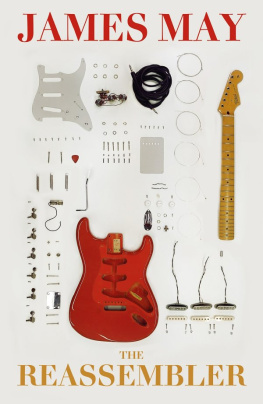This copper and hide mallet is designed for knocking the wheel spinners off vintage cars. Its been used for pretty much everything else but.
So it doesnt bother me that my mobile phone doesnt come apart. By the time I bust it a better one will be available, which is how it should be. The total processing power of the whole world when I was born is now in my back pocket, ready to be sat on and broken, and its come to that through the process of discarding the old and moving on. Taking things apart and mending them just holds us back.
Old things were designed to come apart.
This is where I find myself impaled on the horns of a deep internal conflict. I love reassembly, and Im a tool pervert. And yet, by rights, I should rebuild a 1950s lawnmower and then throw it in the canal, because otherwise I am reintroducing to the world the smoke-belching cacophonous evil that ruined a billion neighbours sunny Sunday afternoons in the garden. A robotic electric hover mower is just better.
Fortunately, I have no desire to retard the world. Reassembly is merely a form of therapy; something that stimulates a part of my brain that is left wanting in my daily life. When I rebuild a bicycle, I re-order my head. So might you.
But thats all it is. Im not an evangelist for it, I dont think it will save the nation, and it doesnt trouble me if the younger generation arent interested another common and pointless lament of the ageing. Why should they be? Theyve got Pokemon Go. I just happen to like putting things together. So I do.
A screwdriver with handy pocket clip, similar to the one used in alarmclockgate.
It began for me around the age of five, and my first reassembly experience was the one that many of you will have suffered since, even in adulthood. That is; it didnt go back together.
The object of my enquiry was my parents bedside alarm clock, and this being the late 60s, it was a proper mechanical device with a huge internal bell, and on which the time to get up could be set on a small subsidiary dial, to within an accuracy of 15 minutes.
The enabling technology in this endeavour was the small, flat-bladed screwdriver (with handy pocket clip) that lived in a drawer in the kitchen (where else?). It was the first tool I understood. I pointed the business end toward the forbidden bedroom and advanced, undetected.
I can still see the three dome-headed and burnished slotted screws that secured the back of this clanking mystery. I knew, innately, that loosening them meant turning them anti-clockwise, even though I was as yet ironically unaware of what clockwise actually signified.
Off came the back: suspiciously easily, I would now realise. More screws lay within, and on I went, like one of Carters archaeologists, unable to resist the lure of the treasure that must soon be revealed to me despite a nagging sense that the whole project was cursed.
I did briefly glimpse the miracle of clockwork, with its gently oscillating balance wheel and train of gears, there to represent through simple arithmetic division the passage of our days. It had a beating heart; a tiny hairspring that contracted and swelled regularly to allow reciprocating mechanical action to assume the linearity of times arrow. It lived! It was amazing.
But then it was gone. All of it. What I didnt appreciate, at the age of five, was the facility that the freshly wound mainspring had for completing the disassembly process for me, and as a quantum event at that. It was there, and then it simply wasnt there any more, scattered to the four skirting boards as the springs impetus, intended to be metered out over 24 hours, was spent in a tiny fraction of time that a crude alarm clock could not in itself record. I was left astonished, clutching the empty shell of the ancestral timepiece, a cartoon boing hanging in the air over my fathers approaching footsteps.
Even today, I approach a spring that is anything other than completely relaxed with deep circumspection, the legacy of a very early bollocking.
Meanwhile, an early distrust of electricity was engendered when I wrapped the wires leading to the working signal lights of my Triang trainset around the live and neutral pins of the plug on the transformer, and then pushed it into the socket. This electrocuted me. Still, the remainder of the trainset was a gloriously tangible thing held together with small brass screws, so would come apart safely.
There is, mercifully, only one spring in one of these old toy trains; the one that holds the brushes against the commutator of the motor. But then, the operation of the whole depends on it, and that, too, broke free with the determination of Airey Neave checking out of Colditz and was never seen again. I carried on anyway.













